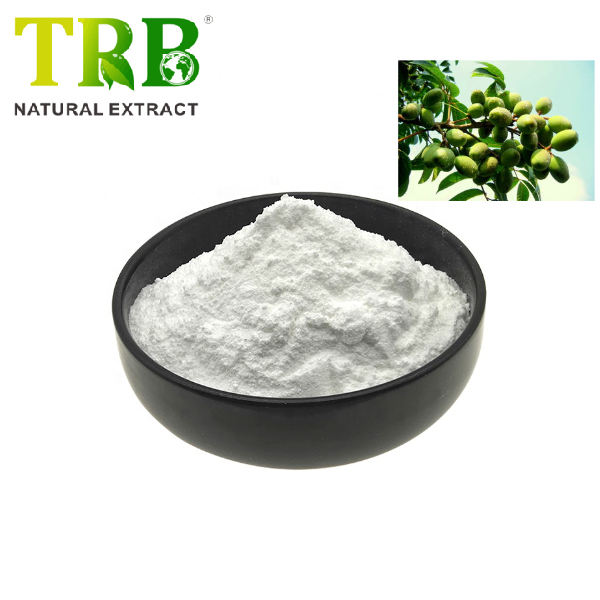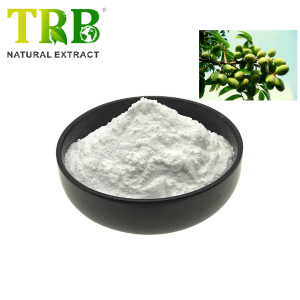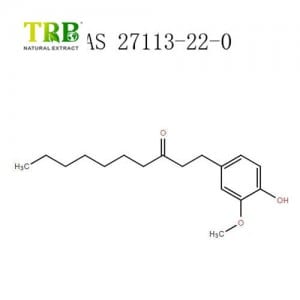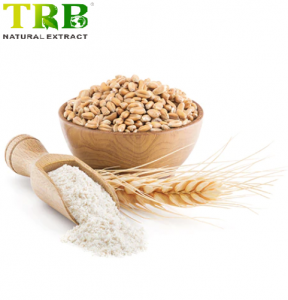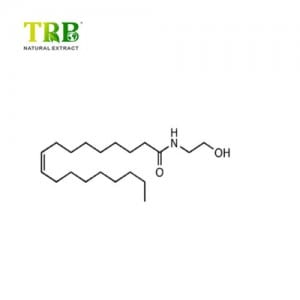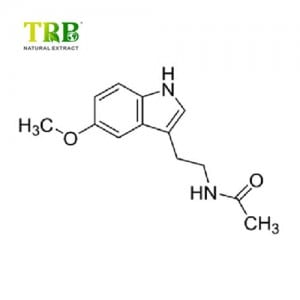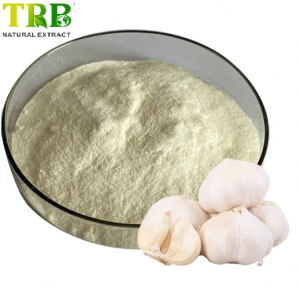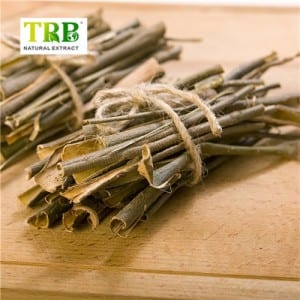Aigéad Oleanolic atá ina trí triterpenoids pentacyclic scoite amach ó phlandaí Gentianaceae de Swertia mileensis an féar iomlán nó torthaí privet, le comhlacht saor in aisce agus gliocóisídí i go leor plandaí.Tá raon leathan ag aigéad oleanolic i bplandaí, agus is é 0.2% - 2% an meán-ábhar.Tá cion ard Cucurbitaceae 1.5% ~ bun hunchback 2%, cion torthaí privet de 0.6% ~ 0.7%. Tá aigéad oleanolic ar chineál an cumaisc triterpenoid pentacyclic scoite ó na torthaí den ghéineas Asteraceae, Syzygium sylvestris, nó Ligustrum lucidum.Is aidiúntóir galar ae é agus úsáidtear é go cliniciúil le haghaidh ionfhabhtú teiripeach.Tá éifeachtaí soiléire ag heipitíteas buíochán géarmhíochaine ar laghdú alanine aminotransferase agus yellowing.Is aigéad olúil triterpenoids pentacyclic scoite amach ó na torthaí swertia chinensis nó fructus ligustris ón ngléasra gentianaceae.Tá aigéad oleanolic le fáil go forleathan i bplandaí, le hábhar ginearálta 0.2% ~ 2% [1].Ba é 1.5% ~ 2% ábhar bun an calabash, agus ba é 0.6% ~ 0.7% ábhar torthaí fructus ligustris.Is criostail aigéadach bán (eatánól), gan bholadh agus gan blas é aigéad oleanólach.Éagobhsaí d'aigéid agus do bhunanna.Leáphointe de 308 ~ 310 ℃, [alfa] 20 d + 73.3 ° (c = 0.15, clóraform, dothuaslagtha in uisce, intuaslagtha i meatánól, eatánól, éitear eitile, aicéatón agus chloroform.Is aigéad Oleanolic triterpenoid a tharlaíonn go nádúrtha, a dháileadh go forleathan i mbianna agus i bplandaí míochaine, a bhaineann le haigéad betulinic.
Fuarthas amach go raibh gníomhaíocht láidir frith-VEID ag aigéad Oleanolic, baineadh úsáid as an aigéad betulinic cumaisc ghaolmhar chun an chéad druga inhibitor aibithe tráchtála a chruthú.Rinneadh staidéar ar dtús air agus scoiteadh é ó roinnt plandaí, lena n-áirítear Rosa woodsii (duilleoga), Prosopis glandulosa (duilleoga agus craobhóga), Phordendron juniperinum (gléasra iomlán), Syzygium claviflorum (duilleoga), Hyptis capitata (gléasra iomlán), agus Ternstromia gymnanthera (aerga). cuid).Cuimsíonn speicis eile Syzygium lena n-áirítear java-úll (Syzygium samarangense) agus úlla róis é.
Ainm Táirge: Aigéad Oleanolic98%
Sonraíocht: 98% de réir HPLC
Foinse na Lus: Sliocht Olea Europea
Ainm Cheimiceach:(3β)-3-Hidroxyolean-12-en-28-aigéad
Uimh CAS:508-02-1
Cuid Úsáidte: Duilleog
Dath: Púdar bán le boladh agus blas sainiúil
Stádas GMO: GMO Saor in Aisce
Pacáil: i drumaí snáithíní 25kgs
Stóráil: Coinnigh an coimeádán gan oscailt in áit fhionnuar, tirim, Coinnigh ar shiúl ó solas láidir
Seilfré: 24 mí ó dháta an táirgthe
Cád éaigéad oleanolic?
Aigéad Oleanólach (OA), aigéad nádúrtha hiodrocsaile pentacyclic triterpenoid (HPTA) cosúil le haigéad betulinic, aigéad ursolic;tá buntáistí aige cosúil le gníomhaíochtaí antibacterial, anti-inflammatory, antitumor.

Cá bhfaighidh túaigéad oleanolic?
Úsáidtear aigéad oleanolic go traidisiúnta le haghaidh cóireáil galair éagsúla, is féidir leat é a fháil go forleathan i mbia agus i bplandaí.
Go bhfuil aigéad oleanolic freisin i roinnt torthaí cosúil le úlla, pomegranate, líomóid, lus an choire, ológa.

| Ainm Luibh | Ábhar aigéad oleanolic | Modh tástála |
| Ligustrum lucidum Ait | 0.8028% | HPLC |
| Verbena Oifigiúil L | 0.071% -0.086% | HPLC |
| Prunella vulgaris L | 3.47%-4.46% | HPLC |
| Hemsley Chinensis Cogn. | 1.5%~2% | HPLC |
Faoi láthair, luibh SínisHemsley Chinensis Cognis é an t-amhábhar tráchtála is mó fós le haigéad oleanolic a bhaint amach.
Hemsley Chinensis Cogn.Réamhrá
Hemsleya chinensis Cogn.Is luibh dreapadóireachta ilbhliantúil, freisin leigheas Sínis traidisiúnta.
Teaghlaigh: Cucurbitaceae
Tribus: Gomphogyneae
Géineas: Hemsleya
Speiceas: H. amabilis
Tá an luibh a dháileadh i gcúigí Guangxi, Sichuan, Guizhou, Yunnan, Hubei, etc Rugadh i imeall na foraoise agus toir ghleann ag airde de thart ar 2,000 méadar.
Comhábhair ghníomhacha: tá Hemslolide Mal、Ma3、H1;Chikusetsusaponin-Iva;dihydro cucurbitacin F-25-aicéatáit;dilydrocucurbitacin F;aigéad oleanolic-béite-Hlucosyloleanolate;Hemsamabilinin A;Cu-curbitacinⅡb-2-beta-D-glucopyranoside.
Luachanna Leighis:
Hemsleya chinensis Cogn.go príomha le haghaidh díthocsainithe, steiriliú, frith-athlastach, neartú na boilg agus pian a mhaolú.Faoi láthair, tá púdar sleachta, nó ullmhóidí cumaisc cosúil le capsúil, táibléad, pills gastrointestinal, etc., a úsáidtear go forleathan i gcleachtas cliniciúil.

Baint aigéad Oleanólach óHemsleya Chinensis Cogn.

Foirmlí ina bhfuil aigéad Oleanolic i forlíontaí bia
Fuaireamar amach go dtagann an t-aigéad oleanolic a úsáidtear i forlíontaí sláinte go príomha ó thrí chineál sleachta plandaí: sliocht duille Loquat, sliocht Hemsley Chinensis, agus sliocht basil naofa.
- Púdar Basil Naofa (duilleog) (0.4% aigéad Ursolic agus aigéad Oleanolic, 2.0 mg)
- Naofa Basil supercritical CO2 sliocht (duilleog) (Ocimum tenuiflorum Linn.) (Aigéad Ursolic 2.5% agus aigéad Oleanolic, 1.5 mg)
- Sliocht Loquat (torthaí) (a sholáthraíonn aigéad Ursolic, Aigéad Oleanólach) (Caighdeánach d'aigéad Ursolic In aghaidh an Freastal 125mg)

Aigéad oleanólach vs aigéad Ursolic
Is triterpenoids nádúrtha iad aigéad Oleanolic (OA) agus aigéad ursolic (UA) a bhfuil struchtúr ceimiceach comhchosúil acu.
Is eol go bhfuil na comhdhúile triterpenoids seo ann i luibheanna agus i mbianna míochaine.
Tá go leor airíonna cógaseolaíochta coitianta acu: gníomhaíochtaí hepatoprotective, anti-inflammatory, antimicrobial, hypoglycemic, antimutagenic, frith-VEID, frithocsaídeoirí agus frith-athlastach.

Difríocht OA agus UA:
| Ainm Táirge | Aigéad oleanolic | Aigéad ursolic |
| CAS UIMH. | 508-02-1 | 77-52-1 |
| Triterpenes Pentacyclic | β-Amyrin | α-Amyrin |
| Foinsí luibhe | Duilleog loquat, Basil Naofa, Rosemary, duille olóige.etc. | |
| Sonraíochtaí | 40%,98% púdar | 15%,25%,50%,98% púdar |
| Dealramh (dath agus boladh) | 40% buí éadrom98% bán gan bholadh | 15% -50% donn-buí nó buí98% púdar bánSaintréith |
| Idirdheal | IR:(1355~1392cm-1) dhá bhuaic(1245~1330cm-1) trí bhuaicNMR:δ(C12)122.1, δ(C13)143.4 | (1355–1392cm-1) trí bhuaic (1245 ~ 1330cm-1) trí bhuaicδ(C12)125.5, δ(C13)138.0 |
| Díorthaigh | Oleanolic sóidiam salannOleanolic aigéad fosfáit dé-óid salann3-oxo aigéad oleanolic meitile bardoxolone (CDDO-Me) | Salann sóidiam Ursolic agus a dhíorthaigh leath-eistir aigéid décharbocsaileacha díorthaigh aigéad ursolic ketene, aigéad ursolic 3-charbóin Aigéad 3-aicéatoxyursolic |
| Frithailse féideartha | Tá níos mó tóir ar UA ná ar OA. | |
Gníomhaíochtaí Bitheolaíochta Aigéad Oleanolic
-
Éifeachtaí Frith-Meall/Frith-ailse
Éifeacht choisctheach aigéad oleanólach ar charcanóma hepatocellular trí ghabháil timthriall cille idirghabhála ERK-p53 agus apoptosis cleithiúnach mitochondrial
– le Xin Wang, Hua Bai, etc. Taighdeoirí
Thaispeáin OA éifeacht coisctheach ar HCC trí ionduchtú apoptóis agus gabháil timthriall cille i siadaí trasphlandaithe agus i gcealla HepG2 araon.
Apoptosis spreagtha OA tríd an gcosán miteachondrial, is léir ó chosc ar sprioc Akt/mamach ar chonair rapamycin.
Gabháil timthriall cille G2/M spreagtha ag OA trí íosrialáil p21-idirghabhála ar chiclin B1/cdc2.
Léirigh OA gníomhaíochtaí suntasacha frith-meall i múnlaí in vivo agus in vitro HCC.Tugann na sonraí seo léargas nua ar na meicníochtaí is bun le héifeacht frith-tumóra OA.
Ina theannta sin, léiríonn taighde go bhfuil éifeachtaí freisin ag OA agus a eistear meitile aigéad Oleanolic díorthaigh ar ailse chíche, ailse scamhóg, ailse lamhnán, ailse cheirbheacsach, cealla ailse pancreatic…

-
Gníomhaíocht Frithmhiocróbach
Táthar ag súil go mbeidh gníomhaíocht fhrithmhiocróbach ag OA i gcoinne raon leathan pataiginí toisc go bhfuil ról ríthábhachtach aige i gcosaint i gcoinne pataiginí i bplandaí.
Léirigh OA gníomhaíocht mheasartha i gcoinne Staphylococcus aureus agus Bacillus Thuringiensis ag 62.5 µg/mL agus Escherichia coli, Salmonella Enterica, agus Shigella dysenteriae ag 31.2 µg/mL tiúchan íosta coisctheach (MIC).
-
Cumas Hepatoprotective
Ceann de na bithghníomhaíochtaí suntasacha de OA ná cosaint an ae ar thocsaineacht agus tá sé á úsáid faoi láthair mar dhruga thar an gcuntar hepatic sa tSín.
I bhfrancaigh Wistar albino, baineadh úsáid as OA ó Flaveria Trinervia agus bhí éifeacht chosanta suntasach aige ar thocsaineacht ae spreagtha ag eatánól trí leibhéil einsím marcóir serum hepatotoxic a athchóiriú.Mhol an staidéar seo cumas frithocsaídeach OA mar mheicníocht féideartha eile dá chumas hepatoprotective.
Aigéad Oleanólach agus a dhíorthaigh

Trialacha Cliniciúla Aigéad Oleanolic
Aigéad oleanolic (foinsithe ó olóige), tá thart ar 500 trialacha cliniciúla cláraithe, léirigh go raibh éifeachtaí tairbheacha aige i dtrialacha cliniciúla ar ghalar duáin ainsealach, diaibéiteas mellitus cineál 2, agus roinnt coinníollacha athlastacha cosúil le airtríteas.
Is iad na díorthaigh is coitianta i dtrialacha cliniciúla ná bardoxolone methyl (CDDO-Me).Rinneadh measúnú ar CDDO-Me i mbithóipí siadaí, agus d'fhéadfadh sé go mbeadh ról aige i gcóireáil galar duáin ainsealach, tá sé á mheasúnú faoi láthair maidir le héifeachtaí ar Hipirtheannas.
Caighdeán Pharmacopoeia na Síne d'Aigéad Oleanolic
| Ainm Táirge | Aigéad Oleanólach |
| Aitheantas | (1) Glac 30mg den táirge seo, cuir i bpromhadán é, cuir 3ml clóraform chun é a thuaslagadh, cuir dhá bhraon d'aigéad sulfarach leis, croith ar feadh 5 nóiméad, tá an ciseal clóraform corcra-dearg. |
| (2) Tóg thart ar 20mg den táirge seo, cuir 1ml d'ainhidríd aicéiteach, déan é a dhíscaoileadh le teas beag, cuir aigéad sulfarach leis an dath corcra, agus dorchaigh tar éis é a chur. | |
| (3) Tóg thart ar 10mg den táirge seo, cuir tuaslagán d'aigéad aicéiteach oighreach vanillin (gabh vanillin 0.5g, cuir 10ml d'aigéad aicéiteach oighreach a thuaslagadh, is é sin) 0.2ml, cuir 0.8ml d'aigéad sárchlórach, agus teas é ar feadh roinnt nóiméad i ndabhach uisce.Fuchsia, cuir 2ml d'aicéatáit eitile, corcra-dearg tuaslagtha in aicéatáit eitile, gan dathú. | |
| (4) Ba cheart go mbeadh speictream ionsúcháin infridhearg an táirge seo comhsheasmhach leis an speictream rialaithe. | |
| Measúnacht a chinneadh | Glac 0.15g den táirge seo, meáigh go cruinn é, cuir 30ml eatánóil, croith é, teas é i ndabhach uisce te chun é a thuaslagadh, lig fuarú go teocht an tseomra, cuir 3 titeann de thuaslagán feanóltailéin táscaire, déan tuaslagán hiodrocsaíd photaisiam le eatánól ( 0.05mol/L) toirtmheascadh láithreach agus ceart le haghaidh tástála bán.Freagraíonn tuaslagán hiodrocsaíd photaisiam (0.05 mol/L) in aghaidh 1 ml eatánóil do 22.84 mg de C30H48O3. |
Aigéad oleanolic dáileog a mholadh
De réir Chaighdeán Pharmacopoeia na Síne, is é an dáileog Béil d'aigéad Oleanolic ná 20 ~ 80 mg in aghaidh an ama, 60 ~ 240 mg in aghaidh an lae.
fo-iarsmaí aigéad oleanolic
Aigéad oleanolic a úsáidtear mar dhruga hepatoprotective thar an gcuntar (OTC) ar feadh na mblianta sa tSín.
Má ródháileog nó mícheart, tá líon beag na n-othar béal tirim, buinneach, míchompord bhoilg uachtair, agus is féidir imíonn siad tar éis cóireála Siomptómach.
Téigh i gcomhairle le do dhochtúir nó le do chógaiseoir sula n-úsáideann tú an táirge seo.
Feidhm:
Tá aigéad 1.Oleanolic sách neamh-tocsaineach, antitumor, agus hepatoprotective, chomh maith le hairíonna antiviral a thaispeáint.
Fuarthas go raibh aigéad 2.Oleanolic chun gníomhaíocht láidir frith-VEID a thaispeáint.
Is cosantóir mór cealla é aigéad 3.Oleanolic i gcoinne strus ocsaídiúcháin agus leictreafile.
Tá éifeacht mhór ag aigéad 4.Oleanolic maidir le heipitíteas víreas a rianú, heipitíteas icteric géarmhíochaine agus heipitíteas ainsealach.
Feidhmchlár:
1. Feidhmeach i réimse an bhia, is féidir leis gníomhú mar amhábhair tae chun phlegm a laghdú;
2. Feidhmeach i réimse cógaisíochta, bíonn sé ina dhruga frith-ailse nua le tocsaineacht íseal;
3. Feidhmeach i réimse cosmaideacha, féadann sé scaipeadh fola a spreagadh agus dí a bhaint.
| Tuilleadh eolais TRB | ||
| Deimhniú rialacháin | ||
| Deimhnithe ISO USFDA, CEP, KOSHER HALAL GMP | ||
| Cáilíocht Iontaofa | ||
| Beagnach 20 bliain, onnmhairiú 40 tír agus réigiún, níos mó ná 2000 mbaisceanna arna dtáirgeadh ag TRB aon fadhbanna cáilíochta, próiseas íonú uathúil, eisíontas agus rialú íonachta freastal ar USP, EP agus CP | ||
| Córas Cáilíochta Cuimsitheach | ||
|
| ▲ Córas um Dhearbhú Cáilíochta | √ |
| ▲ Rialú doiciméad | √ | |
| ▲ Córas Bailíochtaithe | √ | |
| ▲ Córas Oiliúna | √ | |
| ▲ Prótacal Iniúchta Inmheánaigh | √ | |
| ▲ Córas Iniúchta Forlíontaí | √ | |
| ▲ Córas Áiseanna Trealaimh | √ | |
| ▲ Córas Rialaithe Ábhar | √ | |
| ▲ Córas Rialaithe Táirgthe | √ | |
| ▲ Córas Lipéadaithe Pacáistithe | √ | |
| ▲ Córas Rialaithe Saotharlainne | √ | |
| ▲ Córas Fíoraithe Bailíochtaithe | √ | |
| ▲ Córas Gnóthaí Rialála | √ | |
| Rialú Foinsí agus Próisis Iomlána | ||
| Rialú go docht ar gach amhábhar, gabhálais agus pacáistiú materials.Preferred amhábhar agus gabhálais agus pacáistiú ábhar soláthróir le US DMF number.Several soláthraithe amhábhar mar dhearbhú soláthair. | ||
| Institiúidí Comharchumainn Láidre chun tacú | ||
| Institiúid na luibheolaíochta/Institiúid Micribhitheolaíochta/Acadamh Eolaíochta agus Teicneolaíochta/Ollscoil | ||
